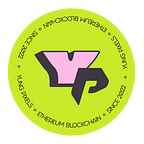CHAPTER 2: A spectrum rounds digital art
If you own a NFT, you are probably being scammed in some way.
And this is not an inherent problem with NFTs. This issue is linked to the current smart contract structure of most NFT projects, especially the profile pic collections (PFPs).
You’ve probably been scammed through one of these two ways: lack of decentralization and transparency (this Chapter) or uncertain randomness (Chapter 3). It is important to say that we wrote this text months ago, and now the current scenario has relatively overcome (thank God) the issue of storage decentralization. However, many projects continue to launch this way and the problem persists — that’s why we consider it very important to still address this issue. The main current problem of the scenario is the uncertain randomness in the mint/reveal processes and new trait releases, which you can understand better in Chapter 3.
For those who still don’t know what a NFT is, we talked about it briefly from Chapter 1, but let’s go back to some important points: NFTs are crypto-assets, which means they are tied to a blockchain. And if you still don’t know what a blockchain is, well… It’s important to understand this technology before investing in NFTs.
NFTs, therefore, have a smart contract, which is a piece of code with a series of conditions to perform one or more specific functions. Smart contracts allow developers to program decentralized applications (dApps) with relative predictability regarding their interaction with a network or ecosystem.
One of the biggest qualities of new blockchain technologies is the promise of decentralization: financial operations between participants without the intermediary of third parties such as banks, brokers or all sorts of corporations. And that’s true for NFTs as well.
What should a NFT actually do? First of all, following the line of thought of chapter 1, art-NFTs are art and don’t need to have necessarily any real use beyond being in a digital collection of crypto millionaires. It may seem strange, but this logic has been moving the art market long before NFTs appeared. And in the same way that rare copies of a modernist collection can be displayed in galleries with public access (without their belonging to the owner being disputed), NFTs can also be freely displayed while guaranteeing their ownership by the holder. That is: NFTs can serve as a signature of ownership and authenticity.
It is easy to imagine that, in this way, NFTs can have practical uses beyond the artistic sphere. Because, once you’re on a blockchain, no one can challenge the legitimacy of a NFT, right?
It turns out that a NFT, as we have seen, has a smart contract, in which the conditions for storing the data of that NFT are defined. A NFT is not exactly an image, but a contract that indicates where that image is stored. And while the contract is indeed tied to the blockchain, the NFT database USUALLY ISN’T.
If a collection launches its NFTs on a given network through a smart contract, but that contract establishes the storage of the data contained in the NFT on a private server, THEN THIS PROJECT IS NOT REALLY DECENTRALIZED and the NFT holder IS NOT THE TRUE OWNER of the project, because whoever controls this server can freely define the course of the project. If the server is for some reason brought down, the entire project can evaporate in the blink of an eye.
The solution to this would be to store the metadata of the NFTs on IPFS, the InterPlanetary File System, a protocol made specifically for decentralized data storage and sharing. However, even if the smart contract defines the storage of the metadata using IPFS, it is still possible to insert in the contract a function called “set baseURI”, which allows a later change of the base URL that the contract recognizes as the storage address of the metadata.
In other words, it is important that the contract structure is really aiming at legitimate decentralization. Otherwise, anyone who thinks they are using NFTs as a property signature is being misled. Many projects still remain under the control of the original developers, but they pass for decentralized because their contracts are tied to blockchains.
IF YOU OWN AN NFT, THE CHANCES OF YOU AND ENTIRE COMMUNITIES ARE BEING HARMED AND SCAMMED BY AMATEUR PROJECTS IS RIDICULOUSLY HIGH. We emphasize that this disastrous problem that surrounds the NFTs marketplace is not purely and simply the greed or bad faith of the developers, but rather, the result of amateurism in the programming of a smart contract, which is becoming the norm — and even reference — among these markets. THE GREAT MAJORITY OF NFT DEVELOPERS ARE AMATEUR. Bear that in mind. In the coming months, it is possible that we will see many collections being reported as CENTRALIZED, that is, still under the control, even if in part, of the original developers.
That’s just the first big problem - and not the biggest one.
Check out Chapter 3 to understand how projects can use uncertain randomness in the processes of mint/reveal to fool entire communities: this is the major problem of the current scenario.
We are developing a different project, a project that revolutionizes the scene, a project that is REALLY decentralized since its genesis and gives freedom of choice to the user.
By giving real decentralization, transparency, true randomness, and the possibility for the user to reveal when — or if — he/she wants, we bring the real sensation of “opening sticker packs” to the NFT scene. This has never been done before - until today.
Yung Pixels is the shape of NFTs to come.
Stay tuned for more information.
Follow our social media:
Twitter: @YungPixels
Instagram: @yungpixels.nft
Website: coming soon
Discord: coming soon
